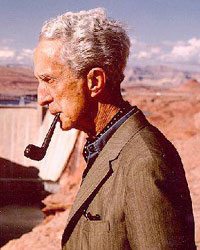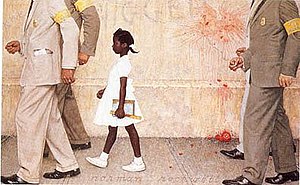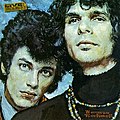Norman Rockwell
Norman Percevel Rockwell | |
|---|---|
 Photographic portrait of Rockwell | |
| Born | February 3, 1894 |
| Died | November 8, 1978 (aged 84) |
| Occupation | Painter |
| Spouse(s) | 1) Irene O'Connor (m. 1916 div. 1930) 2) Mary Barstow (m. Apr 17 1930, her death) 3 children 3) Molly Punderson (m. Oct 25 1961, until his death) |
| Children | Jarvis Waring Rockwell Thomas Rhodes Rockwell Peter Barstow Rockwell |
| Parent(s) | Jarvis Waring and Nancy (Hill) Rockwell |
Norman Percevel Rockwell (February 3, 1894 – November 8, 1978) was a 20th century American painter and illustrator. His works enjoy a broad popular appeal in the United States, where Rockwell is most famous for the cover illustrations of everyday life scenarios he created for The Saturday Evening Post magazine over more than four decades. Among the best-known of Rockwell's works are Rosie the Riveter (although his Rosie was reproduced less than others of the day), Saying Grace (1951), and the Four Freedoms series.
Biography
Early life
Rockwell was born on February 3, 1894, in New York City to Jarvis Waring and Ann Mary Rockwell (nee Hill).
He had one brother, Jarvis Rockwell. Norman transferred from high school to the Chase Art School at the age of 16. He then went on to the National Academy of Design and finally to the Art Students League. There, he he was taught by Thomas Fogarty, George Bridgman, and Frank Vincent Dumond; his early works were produced for St. Nicholas Magazine, the Boy Scouts of America (BSA) publication Boys' Life and other juvenile publications. Joseph Csatari carried on his legacy and style for the BSA.
As a student, Rockwell was given smaller, less important jobs. His first major breakthrough came in 1912 at age eighteen with his first book illustration for Carl H. Claudy's Tell Me Why: Stories about Mother Nature.
Also, in 1913 (aged 19), he became the art editor for Boys' Life, a post he held for several years. As part of that position, he painted several covers between 1913 and 1915. His first published magazine cover, Scout at Ship's Wheel, appeared on Boys' Life September 1913 edition.
World War I
During the First World War, he tried to enlist into the U.S. Navy but was refused entry because, at 6 feet (1.83 m) tall and 140 pounds (64 kg), he was eight pounds underweight. To compensate, he spent one night gorging himself on bananas, liquids and donuts, and weighed enough to enlist the next day. However, he was given the role of a military artist and did not see any action during his tour of duty.
Rockwell moved to New Rochelle, New York at age 21 and shared a studio with the cartoonist Clyde Forsythe, who worked for The Saturday Evening Post. With Forsythe's help, he submitted his first successful cover painting to the Post in 1916, Boy with Baby Carriage (published on May 20). He followed that success with Circus Barker and Strongman (published on June 3), Gramps at the Plate (August 5), Redhead Loves Hatty Perkins (September 16), People in a Theatre Balcony (October 14) and Man Playing Santa (December 9). Rockwell was published eight times total on the Post cover within the first twelve months. Norman Rockwell published a total of 321 original covers for The Saturday Evening Post over 47 years.
Rockwell's success on the cover of the Post led to covers for other magazines of the day, most notably The Literary Digest, The Country Gentleman, Leslie's Weekly, Judge, Peoples Popular Monthly and Life Magazine.
Personal life
Rockwell married his first wife, Irene O'Connor, in 1916. Irene was Rockwell's model in Mother Tucking Children into Bed, published on the cover of The Literary Digest on January 19, 1921. However, the couple divorced in 1930. He quickly married schoolteacher Mary Barstow, with whom he had three children: Jarvis Waring, Thomas Rhodes and Peter Barstow. In 1939, the Rockwell family moved to Arlington, Vermont, which seemed to inspire him to paint scenes of everyday small town American life. Rockwell also was commissioned for several Christmas projects during his early years
World War II

In 1943, during the Second World War, Rockwell painted the Four Freedoms series, which was completed in seven months and resulted in his losing 15 pounds. The series was inspired by a speech by Franklin D. Roosevelt, in which he described four principles for universal rights: Freedom from Want, Freedom of Speech, Freedom to Worship, and Freedom from Fear. The paintings were published in 1943 by The Saturday Evening Post. The U.S. Treasury Department later promoted war bonds by exhibiting the originals in 16 cities. Rockwell himself considered "Freedom of Speech" to be the best of the four. That same year a fire in his studio destroyed numerous original paintings, costumes, and props.
During the late 1940s, Norman Rockwell spent the winter months as artist-in-residence at Otis College of Art and Design. Students occasionally were models for his Saturday Evening Post covers. In 1949, Rockwell donated an original Post cover, "April Fool," to be raffled off in a library fund raiser.
Later, in 1953, his wife Mary died unexpectedly, and Rockwell took time off from his work to grieve. It was during this break that he and his son Thomas produced his autobiography, My Adventures as an Illustrator, which was published in 1960. The Post printed excerpts from this book in eight consecutive issues, the first containing Rockwell's famous Triple Self-Portrait.
Later career
Rockwell married his third wife, retired Milton Academy English teacher, Molly Punderson, in 1961. His last painting for the Post was published in 1963, marking the end of a publishing relationship that had included 321 cover paintings. He spent the next 10 years painting for Look Magazine, where his work depicted his interests in civil rights, poverty and space exploration.

During his long career, he was commissioned to paint the portraits for Presidents Eisenhower, Kennedy, Johnson, and Nixon, as well as those of foreign figures, including Gamal Abdel Nasser and Jawaharlal Nehru. One of his last works was a portrait of legendary singer Judy Garland in 1969.
A custodianship of 574 of his original paintings and drawings was established with Rockwell's help near his home in Stockbridge, Massachusetts, and the museum is still open today year round[1]. For "vivid and affectionate portraits of our country," Rockwell received the Presidential Medal of Freedom in 1977, the United States of America's highest civilian honor.
Norman Rockwell died November 8, 1978 of emphysema at age 84 in Stockbridge, Massachusetts. First Lady Rosalynn Carter attended his funeral.
Body of work


Norman Rockwell was very prolific, and produced over 4000 original works, most of which have been either destroyed by fire or are in permanent collections. Rockwell was also commissioned to illustrate over 40 books including Tom Sawyer and Huckleberry Finn. His annual contributions for the Boy Scouts' calendars between 1925 and 1976 (Rockwell was a 1939 recipient of the Silver Buffalo Award, the highest adult award given by the Boy Scouts of America[2]), were only slightly overshadowed by his most popular of calendar works: the "Four Seasons" illustrations for Brown & Bigelow that were published for 17 years beginning in 1947 and reproduced in various styles and sizes since 1964. Illustrations for booklets, catalogs, posters (particularly movie promotions), sheet music, stamps, playing cards, and murals (including "Yankee Doodle Dandy", which was completed in 1936 for the Nassau Inn in Princeton, New Jersey) rounded out Rockwell's œuvre as an illustrator.
Rockwell's work was dismissed by serious art critics in his lifetime.[3] Many of his works appear overly sweet in modern critics' eyes,[citation needed] especially the Saturday Evening Post covers, which tend toward idealistic or sentimentalized portrayals of American life— this has led to the often-deprecatory adjective "Rockwellesque." Consequently, Rockwell is not considered a "serious painter" by some contemporary artists, who often regard his work as bourgeois and kitsch. Writer Vladimir Nabokov scorned that Rockwell's brilliant technique was put to "banal" use, and wrote in his book Pnin: "That Dalí is really Norman Rockwell's twin brother kidnapped by Gypsies in babyhood". He is called an "illustrator" instead of an artist by some critics, a designation he did not mind, as it was what he called himself.[citation needed]
However, in his later years, Rockwell began receiving more attention as a painter when he chose more serious subjects such as the series on racism for Look.[citation needed] One example of this more serious work is The Problem We All Live With, which dealt with the issue of school integration. The painting depicts a young African American girl, Ruby Bridges, flanked by white federal marshals, walking to school past a wall defaced by racist graffiti.
In 1999, New Yorker art critic Peter Schjeldahl said of Rockwell in ArtNews: “Rockwell is terrific. It’s become too tedious to pretend he isn’t.”[3]
Rockwell's work was exhibited at the Solomon R. Guggenheim Museum in 2001.[4]
Rockwell's Breaking Home Ties sold for $15.4 million at a 2006 Sotheby’s auction.[3]
Influences
- In the film Empire of the Sun, a young boy (played by Christian Bale), is put to bed by his loving parents in a scene also inspired by a Rockwell painting — a reproduction of which is later kept by the young boy during his captivity in a prison camp. (Freedom from Fear, 1943).[citation needed]
- The 1994 film Forrest Gump includes a shot in a school that re-creates Rockwell's "The Shiner" with young Forrest in place of the girl. Much of the film drew heavy visual inspiration from Rockwell's art.[citation needed]
- In the film Lilo and Stitch, the end credits include a parody of Rockwell's Thanksgiving illustration. The participants in the dinner include three aliens, a native Hawaiian woman and child, and an African-American man. (Freedom from Want, 1943).
- The 1988 film Funny Farm featured a scheme concocted by a homeowner (played by Chevy Chase) where redneck townsfolk are bribed to act like the characters of Norman Rockwell's paintings to create the illusion of ideal small-town American life, making the area more appealing to prospective buyers.
- In the film The Polar Express, appears one of the Rockwells' Saturday Evening Post covers, The Discovery (Boy Discovering Santa Suit).
- Film director George Lucas owns Rockwell's original of The Peach Crop, and his colleague Steven Spielberg owns a sketch of Rockwell's Triple Self-Portrait. Each of the artworks hangs in the respective filmmakers' workspaces.[3]
Gallery
-
"The World is one family" at the United Nations, New York City
-
"Day Dreaming Bookkeeper", 1924
-
"Freedom from fear"
-
"Freedom of Worship"
-
Cartoon showing Norman Rockwell's weekly problems with finding new ideas for the cover of The Saturday Evening Post
-
"Breaking Home Ties"
-
Album cover for "The Live Adventures of Mike Bloomfield and Al Kooper" (1968)
Major works
- Scout at Ship's Wheel (1913) (First Published Magazine Cover Illustration)
- Santa and Scouts in Snow (1913)
- Boy and Baby Carriage (1916) (First Saturday Evening Post Cover)
- Circus Barker and Strongman (1916)
- Gramps at the Plate (1916)
- Redhead Loves Hatty Perkins (1916)
- People in a Theatre Balcony (1916)
- Tain't You (1917) (First Life Magazine Cover)
- Cousin Reginald Goes to the Country (1917) (First Country Gentleman Cover)
- Santa and Expense Book (1920)
- Mother Tucking Children into Bed (1921) (First Wife Irene Is the Model)
- No Swimming (1921)
- Santa with Elves (1922)
- Doctor and Doll (1929)
- The Four Freedoms (1943)
- Freedom of Speech (1943)
- Freedom to Worship (1943)
- Freedom from Want (1943)
- Freedom from Fear (1943)
- Rosie the Riveter (1943) [1]
- Going and Coming (1947)
- Bottom of the Sixth (1949)
- Saying Grace (1951)
- Girl at Mirror (1954)
- Breaking Home Ties (1954) [2]
- The Marriage License (1955)
- The Scoutmaster (1956)[3]
- Triple Self-Portrait (1960)
- Golden Rule (1961)
- The Problem We All Live With (1964)
- Southern Justice (Murder in Mississippi) (1965) [4]
- New Kids in the Neighborhood (1967)
- The Rookie
See also
Notes
External links
- Norman Rockwell Museum, Vermont (commercial site)
- Norman Rockwell official web site (commercial site)
- Complete Image Archive of Post-1922 Norman Rockwell Saturday Evening Post Covers (commercial site)
- Norman Rockwell WWII posters, hosted by the University of North Texas Libraries Digital Collections (broken link)
- Norman Rockwell at Find a Grave
- Art Directors Club biography, portrait and images of work
- Articles lacking sources from January 2008
- American artists
- Illustrators
- Members of Art Students League of New York
- United States Navy sailors
- Scouting in popular culture
- People from New York City
- Stockbridge, Massachusetts
- Vermont culture
- Deaths from emphysema
- 1894 births
- 1978 deaths
- American military personnel of World War I

